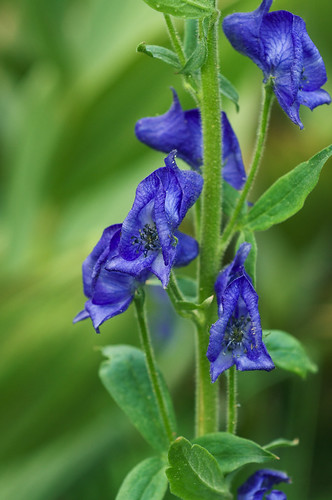Aconitum columbianum by Eric in SF
By now readers know how excited this GardenLady gets when a flower finally bursts into bloom. To this end I want to let everyone know that my monkshood flowers (aconitum) have finally opened. Books generally say this flower opens in mid to late summer. Mine opens in late September or October.
Wolf’s Bane by helen.2006
I bought this flowering plant reluctantly.
Before I discovered the effectiveness of Liquid Fence to spray on plants to prevent deer from eating everything, I sadly complained to friends that I could not raise flowers or vegetables on my property. At that point it seemed that the deer ate everything. A friend told me to get Monkshood or aconite plants because not only did they have have pretty flowers that looked like the purple hood of a medieval monk (see here), it seemed that deer didn’t touch the plant. Deer aren’t stupid. They seem to know which plants are toxic. I wish I understood how they get this knowledge. And Monkshood plants are toxic.
Because I knew of the plant’s toxicity, I feared having it on my property. In a way, I realize how silly I was because there are a lot of pretty flowering plants that are toxic if eaten. Besides being poisonous when eaten, the Monkshood plant can also cause an allergic reaction to some people if just touched. It is said that Monkshood makes pretty cut flowers, but if you touch the plants while putting them in a vase, you should wash your hands thoroughly. Even though I do not have children living at home, I planted my Monkshood in the back of my house in an area that is terraced and therefore out of the way. Nothing ever steps in its location. And as pretty as the flower is, even though I have never seemed to have an allergic reaction when I touched the plant to tie it up when it flopped, I didn’t bring it indoors for floral arrangements. Why worry that someone may touch it when it is in a vase?
Because of the toxicity of Monkshood, it has been given some some wicked common names. It is called Devil’s Helmet, Wolf’s bane or Leopard’s Bane. Wolf’s bane is a direct translation of the Greek word Lycotonum. The Greeks left the plant as poisonous bait for wolves or anointed arrows with the juice of the herb in order to kill wolves. I wonder if it was used to kill leopards.
Of the 100 perennial or biennial species, I have what I think is the commonest kind, aconitum napellus, which has been used both as a poison and medicinally. See here.
The Monkshood plant is tolerant of most soils though it is best grown in cool, moist, neutral or slightly acid fertile soil. It should be planted with the crown about one inch down. Monkshood prefers partial shade but will grow in full sun. Taller aconites, like mine, need staking.
I have read that Monkshood can be divided every third year in autumn or early spring though it might be slow to re-establish. But one of my favorite sources, an older garden book, says that the plants may be left undisturbed for years. Being lazy, I prefer that advice. So my aconite has never been divided.
These plants can be grown from seed sown in late autumn.



Aconitum Napellus is popular most poisonous garden plants. It has the unpleasant and distinctive taste. That’s why the accidental poisoning cases are almost unknown or too rare.